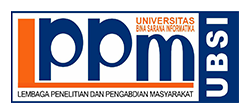Grouping Data in Predicting Infant Mortality Using K-Means and Decision Tree
DOI:
https://doi.org/10.31294/paradigma.v24i2.1399Keywords:
Decission Tree, K-Means, Baby DeathAbstract
Death is something that we cannot avoid where, when and how death comes. The high infant mortality rate is the main thing and the Indonesian government must prioritize, one of the government's efforts to reduce infant mortality is by conducting a surveillance program, namely PWS KIA where the program is uniting the health of mothers and babies in the local area, basically there are several infant deaths that have causes from the time of pregnancy, accidents, disasters, diseases or because it is destiny from God, for that research is carried out in classifying infant mortality data. For grouping infant mortality data, a K-Means method is needed to analyze data by carrying out a data modeling process without supervision or also known as unsupervised learning. In showing the centroid in the early stages of the k-means algorithm, it is very influential on the results of the cluster carried out on the infant mortality dataset. taken from data.go.id with different centroid results. The results of the clustering model pattern that can be trusted by the government or the Health department to prevent infant mortality. From the clustering results, four labels are tested again using the decision tree algorithm.
References
Aditya, K. B., Setiawan, Y., & Puspitaningrum, D. (2018). Sistem Informasi Geografis Pemetaan Faktor-Faktor Yang Mempengaruhi Angka Kematian Ibu (Aki) Dan Angka Kematian Bayi (Akb) Dengan Metode K-Means Clustering (Studi Kasus: Provinsi Bengkulu). Jurnal Teknik Informatika, 10(1), 59–66. https://doi.org/10.15408/jti.v10i1.6817
Arifin, T., & Herliana, A. (2020). Optimizing decision tree using particle swarm optimization to identify eye diseases based on texture analysis. Jurnal Teknologi Dan Sistem Komputer, 8(1), 59–63. https://doi.org/10.14710/jtsiskom.8.1.2020.59-63
Charbuty, B., & Abdulazeez, A. (2021). Classification Based on Decision Tree Algorithm for Machine Learning. Journal of Applied Science and Technology Trends, 2(01), 20–28. https://doi.org/10.38094/jastt20165
Clusterisasi, U., Mahasiswa, N., Asal, B., & Mardiani, S. (2008). Perbandingan Algoritma K-Means dan EM. 316–325.
Flenady, V., Wojcieszek, A. M., Ellwood, D., Leisher, S. H., Erwich, J. J. H. M., Draper, E. S., McClure, E. M., Reinebrant, H. E., Oats, J., McCowan, L., Kent, A. L., Gardener, G., Gordon, A., Tudehope, D., Siassakos, D., Storey, C., Zuccollo, J., Dahlstrom, J. E., Gold, K. J., … Silver, R. M. (2017). Classification of causes and associated conditions for stillbirths and neonatal deaths. Seminars in Fetal and Neonatal Medicine, 22(3), 176–185. https://doi.org/10.1016/j.siny.2017.02.009
Kohno, A., Techasrivichien, T., Pilar Suguimoto, S., Dahlui, M., Nik Farid, N. D., & Nakayama, T. (2020). Investigation of the key factors that influence the girls to enter into child marriage: A meta-synthesis of qualitative evidence. PLoS ONE, 15(7 July), 1–20. https://doi.org/10.1371/journal.pone.0235959
Nazeer, K. A. A., & Sebastian, M. P. (2009). Improving the Accuracy and Efficiency of the k-means Clustering Algorithm. Proceedings of the World Congress on Engineering, I(July 2009), 6.
Oktavia, R., Hardinata, J. T., & Irawan, I. (2020). Penerapan Metode Algoritma K-means Dalam Pengelompokan Angka Harapan Hidup Saat Lahir Menurut Provinsi. Kesatria: Jurnal Penerapan …, 1(4), 154–161. http://tunasbangsa.ac.id/pkm/index.php/kesatria/article/view/41
Ridwansyah, Riyanto, V., Hamid, A., Rahayu, S., & Purnama, J. J. (2022). Laporan Akhir Penelitian:Pengelompokan Dalam Memprediksi Data Kematian Bayi Menggunakan K-Means dan Decision Tree.
Salina, F. H., Almeida, I. A. de, & Bittencourt, F. R. (2019). Renewable Energy and Sustainable Buildings.
Santiko, I., Kurniawan, D., & Astuti, T. (2018). Clustering Berat Bayi Lahir Rendah Berdasarkan Anthropometri Menggunakan Metode K-Mean. Citisee, 121–124.
Suniantara, I. K. P., Hendayanti, N. P. N., & Suwardika, G. (2020). K-Means Bootstrap Analysis in the Birth Weight Classification of the Born Babies. International Journal of Advances in Scientific Research and Engineering, 06(04), 99–105. https://doi.org/10.31695/ijasre.2020.33794
Syamsu, S., Muhajirin, M., & Wijaya, N. S. (2019). Rules Generation Untuk Klasifikasi Data Bakat dan Minat Berdasarkan Rumpun Ilmu Dengan Decision Tree. Inspiration: Jurnal Teknologi Informasi Dan Komunikasi, 9(1), 40. https://doi.org/10.35585/inspir.v9i1.2495
Wulan Sari, R., Wanto, A., & Perdana Windarto, A. (2018). KOMIK (Konferensi Nasional Teknologi Informasi dan Komputer) IMPLEMENTASI RAPIDMINER DENGAN METODE K-MEANS (STUDY KASUS: IMUNISASI CAMPAK PADA BALITA BERDASARKAN PROVINSI). 2(1), 224–230. http://ejurnal.stmik-budidarma.ac.id/index.php/komik
Downloads
Published
How to Cite
Issue
Section
License
Copyright (c) 2022 Ridwansyah, Verry Riyanto, Abdul Hamid, Sri Rahayu, Jajang Jaya Purnama

This work is licensed under a Creative Commons Attribution-ShareAlike 4.0 International License.
Paradigma is an open-access article distributed under the terms of the Creative Commons Attribution-ShareAlike 4.0 International License (https://creativecommons.org/licenses/by-sa/4.0/) , This license permits: Share — copy and redistribute the material in any medium or format for any purpose, even commercially, Adapt — remix, transform, and build upon the material for any purpose, even commercially.




















 Jl. Kramat Raya No.98, Kwitang, Kec. Senen, Kota Jakarta Pusat, DKI Jakarta 10450
Jl. Kramat Raya No.98, Kwitang, Kec. Senen, Kota Jakarta Pusat, DKI Jakarta 10450
